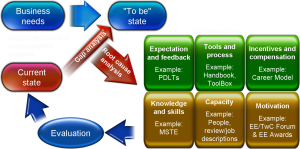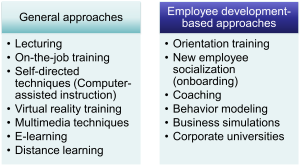8-4: Training Delivery

Now for the exciting part – how training actually gets delivered! Organizations employ diverse delivery methods to achieve different training objectives and accommodate various organizational constraints. Understanding the strengths and limitations of different approaches enables optimal selection for specific training needs.
Lecture
Let’s start with the classic: lecture remains widely used for teaching important work-related information, particularly when large groups need to receive consistent content efficiently. However, lecture approaches typically lack important learning principles such as active practice and immediate feedback.
While lectures can effectively convey factual information, they prove less effective for developing problem-solving skills and interpersonal communication capabilities. Despite potential limitations, lectures can be effective when properly designed and remain relatively inexpensive to implement. Don’t write off lectures entirely – they have their place, especially for foundational knowledge.
On-the-Job Training
On-the-job training represents the most widely used training technique, based on the assumption that trainees can learn through observation of experienced workers and hands-on experience with actual job materials. Apprenticeships exemplify formal on-the-job training approaches, combining practical instruction with minimum annual classroom requirements.
The primary weakness of on-the-job training involves dependence on the skills and motivation of designated trainers. Organizations often assign training responsibilities to whoever happens to be available when new employees arrive, rather than selecting individuals with appropriate training capabilities and motivation. This is like playing trainer roulette – sometimes you get lucky, sometimes you don’t.
Job rotation involves moving employees through various departments, areas, or positions to develop broader skill sets than would result from remaining in single roles. Entry-level human resource employees might rotate through staffing, compensation, benefits, and training areas to learn all HR functions.
Self-Directed Techniques
Self-directed techniques use self-instructional materials that enable trainees to progress at their own pace while incorporating important learning principles. Programmed instruction presents material in small, logical elements with performance testing and feedback.
Online compliance training often employs programmed instruction approaches. However, self-directed techniques may prove ineffective when trainees employ counterproductive strategies or lack motivation for self-regulation. Self-direction works great for motivated learners, but can be a disaster for those who need more structure.
Simulators and Virtual Reality Training
Simulators and virtual reality training employ realistically designed equipment to optimize positive transfer while avoiding dangers, costs, and inefficiencies associated with training on actual equipment. Simulator effectiveness depends on both physical fidelity (extent to which equipment operation mimics real-world conditions) and psychological fidelity (extent to which behavioral processes required for job success are necessary for simulation success).
Recent research by Chernikova et al. (2020) demonstrated through meta-analysis that simulation-based learning in higher education shows significant positive effects, particularly when combined with scaffolding techniques such as examples, prompts, and reflection phases.
Multimedia Techniques
Multimedia techniques use various media resources as training foundations and prove at least as effective as traditional lectures while offering greater flexibility. Trainees can pause, repeat, or stop presentations as needed and access training from various locations and times.
Multimedia approaches often generate greater interest and satisfaction than traditional lectures, though production quality significantly influences trainee acceptance and engagement. Good multimedia training feels like watching an engaging documentary rather than sitting through a boring lecture.
E-Learning (Web-Based Learning)
E-learning delivers training via the Internet, enabling employees at remote locations to access, process, and work with information at their convenience. E-learning provides learner control and can incorporate discussion groups for peer interaction. Content can be updated and changed easily compared to traditional materials.
Research suggests that e-learning may be slightly more effective than classroom-based training for certain objectives. Sitzmann, Kraiger, Stewart, and Wisher (2006) conducted a comprehensive meta-analysis comparing web-based and classroom instruction, finding that web-based instruction was 6% more effective for teaching declarative knowledge and had equivalent effectiveness for procedural knowledge, while requiring 60% less time to complete.
Coaching
Coaching involves supervisors providing subordinates with advice and information about current performance while discussing ideas and goals for improvement. Effective coaching helps trainees understand performance expectations, encourages collaboration between supervisors and subordinates, improves communication, and establishes frameworks for developing both short-term and long-term career goals.
Executive Coaching
Executive coaching typically involves external consultants developing relationships with mid- to high-level executives to enhance leadership effectiveness. Trainee feedback orientation and the feedback culture of organizations significantly affect coaching effectiveness.
Behavioral Modeling
Behavioral modeling applies social learning theory principles by having trainees mimic behaviors demonstrated by exemplary models. This approach proves especially effective for interpersonal skills training. Research demonstrates that behavioral modeling training can result in positive trainee reactions, improved learning test scores, and better on-the-job performance compared to control groups.
Burke and Day (1986) found that behavioral modeling was among the most effective training methods for developing managerial skills, particularly when combined with practice opportunities and feedback sessions.
Business Simulations and Management Games
Business simulations and management games present organizational situations where managers must make decisions that subsequently affect outcomes. These approaches are generally well-received by trainees who find them interesting, relevant, and realistic. However, competitive elements may cause trainees to focus on winning rather than learning general principles.
Corporate Universities
Corporate universities provide continuous training and development through modern facilities with up-to-date technology for effective learning and transfer. Examples include McDonald’s Hamburger University, Xerox’s Document University, and Caterpillar Training Institute. Approximately 1,800 corporate universities operate in the United States, reflecting organizational commitment to comprehensive employee development.
Training Repayment Agreement Provisions (TRAPs)
Training repayment agreement provisions (sometimes called TRAPs) require workers to pay for training costs if they leave organizations before minimum time periods. These agreements function similarly to noncompete clauses by compelling workers to remain with organizations through debt threats. Critics argue that such provisions reduce worker bargaining power and suppress wages by preventing employees from seeking better opportunities in competitive labor markets.
Cutting-Edge Innovations in Training
As organizations strive to remain competitive in rapidly evolving environments, cutting-edge innovations in training are transforming how employees learn and develop.
AI-Powered Adaptive Learning Platforms
Artificial Intelligence (AI) is revolutionizing training through adaptive learning platforms that personalize content based on individual learner profiles. These systems analyze performance data, learning preferences, and engagement patterns to deliver customized learning paths.
Strategic benefits include increased learner engagement, improved retention, and efficient use of training resources. However, implementation challenges include ensuring data privacy, avoiding algorithmic bias, and integrating AI systems with existing learning management infrastructure.
Immersive VR/AR Simulations
Virtual Reality (VR) and Augmented Reality (AR) technologies provide immersive training experiences that replicate real-world scenarios. These simulations are particularly effective for high-risk environments, complex procedures, and interpersonal skill development.
Strategic benefits include enhanced realism, safe practice environments, and accelerated skill acquisition. Implementation challenges involve high development costs, hardware requirements, and ensuring accessibility for all employees.
Ethical Considerations in Data-Driven Training Personalization
As training becomes increasingly data-driven, ethical considerations must be addressed to protect employee rights and maintain trust. Key concerns include informed consent for data collection, transparency in how data is used, and fairness in algorithmic decision-making.
Organizations must establish clear policies and governance structures to ensure ethical use of training data while leveraging its potential to enhance learning outcomes.

Media Attributions
- Change the Human Performance Way © Ericbrec is licensed under a CC BY-SA (Attribution ShareAlike) license
- Training Delivery
